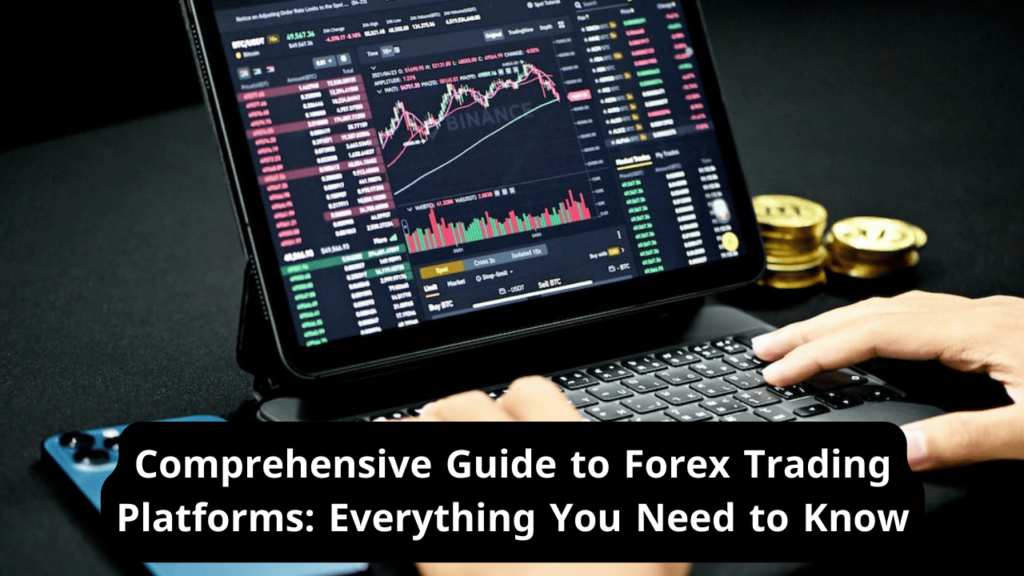
Introduction
Forex (foreign exchange) trading platforms play a crucial role in facilitating global currency trading for retail and institutional investors. This comprehensive guide explores the world of forex trading platforms, covering everything from choosing the right platform to advanced trading strategies. Whether you’re new to forex or looking to enhance your trading skills, this article provides valuable insights to navigate forex platforms effectively.
1. Understanding Forex Trading Platforms
1.1. What are Forex Trading Platforms?
- Definition and role of forex trading platforms in the financial markets.
- Types of platforms: desktop, web-based, and mobile apps.
1.2. Key Features of Forex Platforms
- Real-time currency quotes and charts.
- Order execution capabilities (market orders, limit orders, etc.).
- Technical analysis tools and indicators.
1.3. Types of Forex Brokers
- Dealing Desk (DD) vs. No Dealing Desk (NDD) brokers.
- ECN (Electronic Communication Network) and STP (Straight Through Processing) brokers.
2. Choosing the Right Forex Platform
2.1. Factors to Consider
- Regulation and reliability of the broker.
- Trading costs: spreads, commissions, and overnight fees.
- Range of currency pairs and other financial instruments offered.
2.2. User Interface and Experience
- Ease of navigation and accessibility of trading tools.
- Customizability of charts and trading interfaces.
2.3. Mobile Trading
- Importance of mobile compatibility for trading on the go.
- Features of a good mobile trading app.
3. Getting Started on a Forex Trading Platform
3.1. Opening an Account
- Step-by-step guide to registering with a forex broker.
- Account verification (KYC) and funding options.
3.2. Demo Trading
- Benefits of using a demo account for practice.
- How to use a demo account effectively to learn trading strategies.
3.3. Funding Your Trading Account
- Depositing funds into your trading account using various payment methods.
- Understanding margin and leverage in forex trading.
4. Navigating the Forex Trading Interface
4.1. Dashboard Overview
- Layout of the trading dashboard and key elements.
- Customizing the interface to suit your trading preferences.
4.2. Placing Trades
- How to execute market orders and pending orders (buy/sell limits, stop-loss orders).
- Managing open positions and monitoring profit/loss.
4.3. Analyzing Charts and Indicators
- Using technical analysis tools (moving averages, RSI, MACD) to identify trading opportunities.
- Interpreting candlestick patterns and chart patterns.
5. Basic Forex Trading Strategies
5.1. Trend Trading
- Identifying and following market trends using trendlines and indicators.
- Strategies for trading with the trend and maximizing profits.
5.2. Range Trading
- Trading within established price ranges using support and resistance levels.
- How to identify range-bound markets and execute trades accordingly.
5.3. Breakout Trading
- Strategies for trading breakouts of key price levels.
- Using momentum indicators to confirm breakout signals.
6. Advanced Forex Trading Strategies
6.1. Scalping
- Overview of scalping as a high-frequency trading strategy.
- Techniques for executing quick trades and managing risk.
6.2. Carry Trade
- Understanding the carry trade strategy and interest rate differentials.
- Risks and considerations when engaging in carry trades.
6.3. Hedging
- Using hedging techniques to mitigate currency risk in forex trading.
- Strategies for hedging against adverse market movements.
7. Risk Management in Forex Trading
7.1. Position Sizing
- Calculating position sizes based on risk tolerance and account size.
- Using leverage responsibly and setting appropriate stop-loss levels.
7.2. Psychological Aspects of Trading
- Managing emotions such as fear and greed during trading.
- Techniques for maintaining discipline and consistency.
7.3. Diversification
- Importance of diversifying currency pairs and trading strategies.
- Building a balanced forex trading portfolio.
8. Utilizing Additional Tools and Resources
8.1. Economic Calendar
- Importance of economic news and events in forex trading.
- How to use an economic calendar to plan trades.
8.2. Trading Signals and Analysis
- Using forex signals and third-party analysis for trade ideas.
- Evaluating the reliability of trading signals providers.
8.3. Educational Resources
- Accessing educational materials, webinars, and tutorials provided by forex brokers.
- External resources for learning about forex trading strategies and market analysis.
9. Keeping Up with Forex Market Trends and News
9.1. Market Analysis and Commentary
- Following market analysis reports and expert insights.
- Impact of geopolitical events and economic data on currency markets.
9.2. Social Trading and Community Engagement
- Participating in social trading platforms and copying trades of successful traders.
- Engaging with the forex trading community on forums and social media.
9.3. Regulatory Developments
- Understanding regulatory changes and their impact on forex trading.
- Compliance with global financial regulations and best practices.
Conclusion
Forex trading platforms provide a gateway to the global currency markets, offering traders opportunities for profit and risk management. By understanding the fundamentals, mastering trading strategies, and leveraging advanced tools, traders can navigate forex platforms with confidence. Continuous learning and adaptation to market conditions are essential for success in the dynamic world of forex trading.